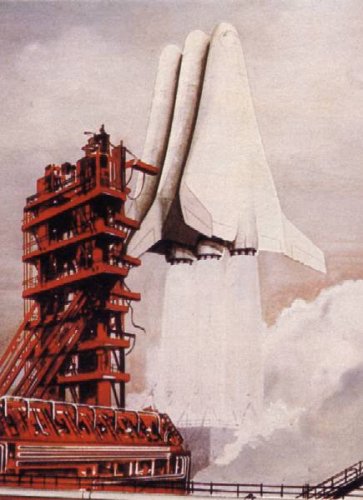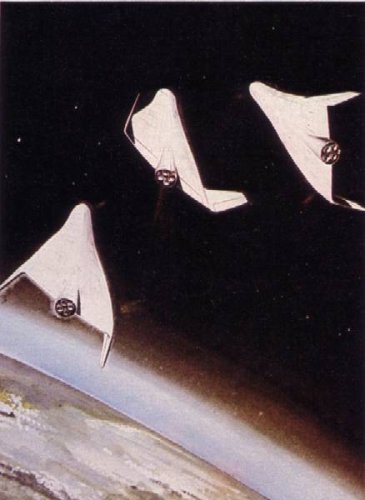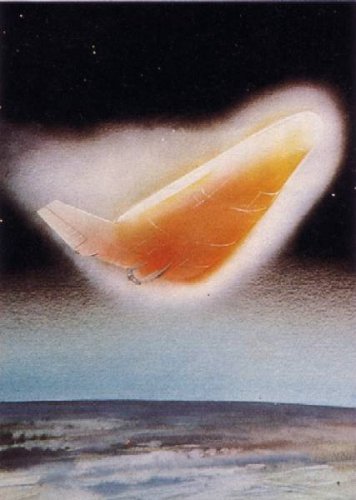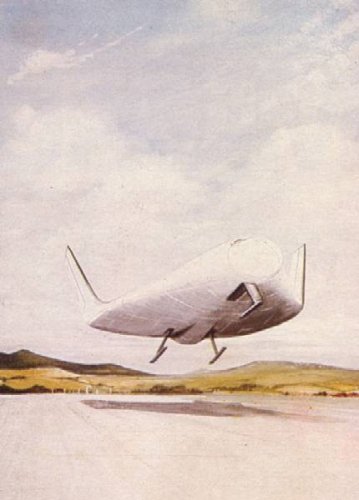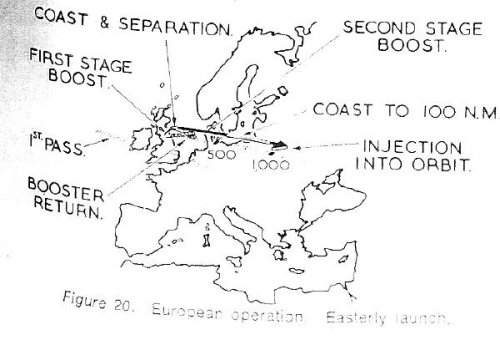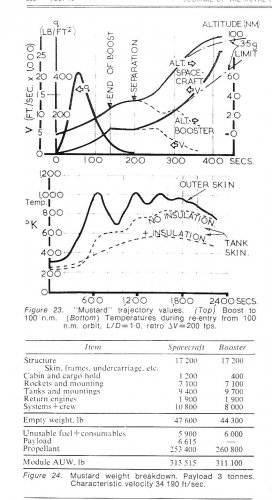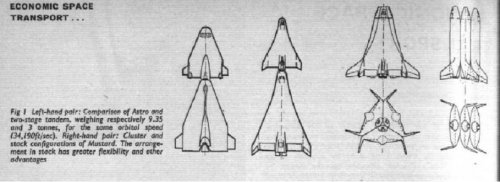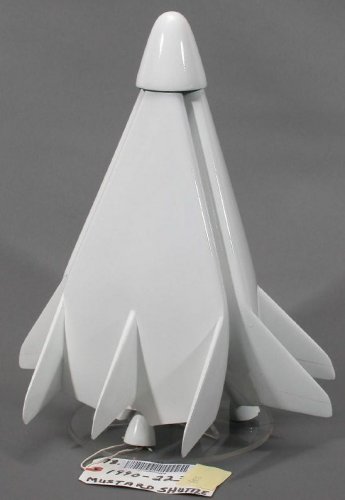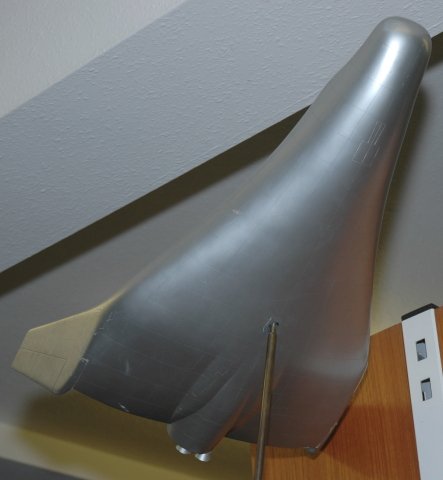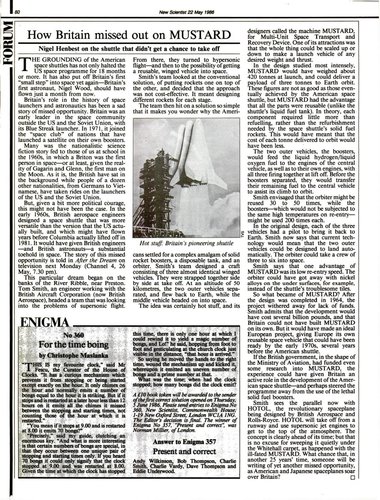You are using an out of date browser. It may not display this or other websites correctly.
You should upgrade or use an alternative browser.
You should upgrade or use an alternative browser.
BAC Multi-Unit Space Transport and Recovery Device (MUSTARD)
- Thread starter hesham
- Start date
- Joined
- 29 September 2006
- Messages
- 1,791
- Reaction score
- 1,358
hesham said:Hi,
In the Flightglobal I found that project for BAC.
http://www.flightglobal.com/FlightPDFArchive/1966/1966%20-%200663.pdf
Thanks Hesham, that's the BAC MUSTARD - Multi-Unit Space Transport and Recovery Device.
One of my favourite space projects.
More info can be found at http://www.unrealaircraft.com/wings/bac_mustard.php and http://www.geocities.com/CapeCanaveral/Launchpad/6133/60planes.html.
Sadly, not much else out there on this project. There was an article in the British "Space Voyager" magazine in the 1980's. Does anyone have it?
Starviking
I have it (there was an article in one issue, and plans in another - I have both). Don't know what the position is with copyright, though (re: posting stuff).starviking said:There was an article in the British "Space Voyager" magazine in the 1980's. Does anyone have it?
Yes those two issues of Space Voyager were rather good ones - Orionblamblam did a great article with lots of other diagrams in one of his APR's as well. Wasn't there a CRESS project as well?
The British Interplanetary Society's 'Space Chronicle' has a good article on UK Spaceplanes including Mustard.
Vol 59, Suppl. 2, 2006
There was also a version that had the three modules arranged in a triangle, god knows how the separation would work for that...
Vol 59, Suppl. 2, 2006
There was also a version that had the three modules arranged in a triangle, god knows how the separation would work for that...
Here are the colour paintings published in 'Space Voyager' back in the 1980s. Although the magazine is long defunct, I'm unsure as to copyright restrictions, so in line with the site's rules, I am posting them as lo-res (maximum 600 pixels height) for 'fair use'. If anyone can confirm if I can post higher res versions, I'll happily do so.
BTW, marvellous image of the glider research vehicle, TsrJoe, thanks!
BTW, marvellous image of the glider research vehicle, TsrJoe, thanks!
Attachments
Found a patent on the vehicles radiator system!
http://www.google.com/patents?id=kjhpAAAAEBAJ&dq=3536278
Regards,
Barry
http://www.google.com/patents?id=kjhpAAAAEBAJ&dq=3536278
Regards,
Barry
Journal of the Royal Aeronautical Society Vol 70 Aug 1966.
Article by T.W. Smith, BSc, FBIS
British Aircraft Corporation, Preston Division
Launch: All motors burning. First stage cut-off occurs 150 seconds from launch, at a velocity of 6,600ft/sec. Altitude is then 30 n.m.
Separation: During a short coast phase the vehicle connections are released. Spacecraft relights main motors and achieves parking orbit 1000 n.m. and 10 minutes from launch.
Spacecraft re-entry: Re-entry is initiated 11,000 n.m. from landing. The hypersonic L/D of 1.0 gives a footprint width of 1360 n.m.
Booster return: During re-entry, the peak heating and maximum g 5.1 occur 270 n.m from launch. Following the 300 n.m. subsonic fly-back, the booster lands at 100 kt.
Article by T.W. Smith, BSc, FBIS
British Aircraft Corporation, Preston Division
Launch: All motors burning. First stage cut-off occurs 150 seconds from launch, at a velocity of 6,600ft/sec. Altitude is then 30 n.m.
Separation: During a short coast phase the vehicle connections are released. Spacecraft relights main motors and achieves parking orbit 1000 n.m. and 10 minutes from launch.
Spacecraft re-entry: Re-entry is initiated 11,000 n.m. from landing. The hypersonic L/D of 1.0 gives a footprint width of 1360 n.m.
Booster return: During re-entry, the peak heating and maximum g 5.1 occur 270 n.m from launch. Following the 300 n.m. subsonic fly-back, the booster lands at 100 kt.
Attachments
And this one for an attachable transport trolley.
http://www.google.com/patents?id=WKs6AAAAEBAJ&printsec=abstract&zoom=4&dq=Walley
http://www.google.com/patents?id=WKs6AAAAEBAJ&printsec=abstract&zoom=4&dq=Walley
- Joined
- 29 September 2006
- Messages
- 1,791
- Reaction score
- 1,358
Some more Flight stuff on MUSTARD
http://www.flightglobal.com/pdfarchive/view/1966/1966%20-%200816.html
http://www.flightglobal.com/pdfarchive/view/1966/1966%20-%200816.html
- Joined
- 29 September 2006
- Messages
- 1,791
- Reaction score
- 1,358
Archibald said:What are drawbacks of Biamese / Triamese -type launchers such as this Mustard or (expendable) Delta 4H ?
Well, for an expendable, like the Delta IV Heavy, the drawback is that the launcher is heavier than an equivalent-payload launcher that doesn't use strap-ons. But to get that equivalent launcher you have to develop it - much easier to strap boosters to an already-designed launcher.
There are probably some drag effects from the strap-ons and the strap-on/booster interface.
Same applies to the MUSTARD - overall heavier than a 2-stage RLV of equivalent payload.
Starviking
Model, Space Shuttle, British Aircraft Corporation MUSTARD Triamese Concept from the Smithsonian National Air and Space Museum Collections Database web site.
This British Aircraft Corporation concept for a fully reusable space transportation system was studied long before the Shuttle research effort in 1969-1972. First presented in 1962, the design was called MUSTARD (Multi-Unit Space Transport and Recovery Device). It featured three piloted lifting-body vehicles - two boosters and an orbiter - that would be launched either stacked or clustered. During ascent the spent boosters would separate and be flown like a glider back to land, and the orbiter would continue into space and later make a gliding return. All propellants were carried inside each vehicle. The origin of this model is unknown; it may have come to the Museum from its designer, British Aircraft Corporation.
Attachments
- Joined
- 22 April 2012
- Messages
- 2,257
- Reaction score
- 2,301
Some sad news that is applicable here:
http://www.telegraph.co.uk/news/obituaries/technology-obituaries/9649596/Tom-Smith.html
Tom Smith, who has died aged 85, led a team of aeronautical engineers at the British Aircraft Corporation (BAC) which, in the 1960s, produced full plans for a British Space Shuttle, long before Enterprise, Columbia or Challenger were even a gleam in an American designer’s eye.
http://www.telegraph.co.uk/news/obituaries/technology-obituaries/9649596/Tom-Smith.html
- Joined
- 1 April 2006
- Messages
- 11,378
- Reaction score
- 10,223
- Joined
- 26 May 2006
- Messages
- 34,879
- Reaction score
- 15,746
flateric said:apparently have found these on Flickr, but don't remember who was that nice person who posted 'em
apparently from Smithsonian
Wow,lovely one,thank you my dear Flateric.
- Joined
- 1 April 2006
- Messages
- 11,378
- Reaction score
- 10,223
A model of the MUSTARD lifting body, a British version of the space shuttle, designed in the 1960's. On display at the British Interplanetary Society Headquarters in Vauxhall, London, UK
by https://www.flickr.com/photos/richards_photos/
some nice panel lines & details there
by https://www.flickr.com/photos/richards_photos/
some nice panel lines & details there
Attachments
RavenOne
ACCESS: Top Secret
- Joined
- 18 June 2008
- Messages
- 1,003
- Reaction score
- 2,675
Am waiting for this book to be available on Amazon to buy, be intersting read.

Though begs the question, I guess it was politics, more politics thrown in with money which curtailed MUSTARD?
On the other hand, if we went ahead of it then all testing and launch would be from Woomera..
cheers

Though begs the question, I guess it was politics, more politics thrown in with money which curtailed MUSTARD?
On the other hand, if we went ahead of it then all testing and launch would be from Woomera..
cheers
Rhinocrates
ACCESS: Top Secret
- Joined
- 26 September 2006
- Messages
- 3,050
- Reaction score
- 7,767
The British Interplanetary Society's November issue of Spaceflight (Vol 58 No 11) has an article on MUSTARD by Daniel Sharp that can be read as a preview. Six pages crammed with detail, some old and new illustrations promising a fascinating book.
Among the reasons for the cancellation were the Outer Space Treaty of 1967 outlawing orbital weapons and the rapid development of American satellite technology which took away much of the rationale for the programme. Incidental were tensions with European competitors.
There's an article in a 2006 issue of the JBIS (I don't have it) in which people involved in the programme reflect that at the time it seemed the most compelling, with higher operating costs than some competing concepts but much lower technology risk.
Among the reasons for the cancellation were the Outer Space Treaty of 1967 outlawing orbital weapons and the rapid development of American satellite technology which took away much of the rationale for the programme. Incidental were tensions with European competitors.
There's an article in a 2006 issue of the JBIS (I don't have it) in which people involved in the programme reflect that at the time it seemed the most compelling, with higher operating costs than some competing concepts but much lower technology risk.
FighterJock
ACCESS: Above Top Secret
- Joined
- 29 October 2007
- Messages
- 5,598
- Reaction score
- 5,928
Rhinocrates said:The British Interplanetary Society's November issue of Spaceflight (Vol 58 No 11) has an article on MUSTARD by Daniel Sharp that can be read as a preview. Six pages crammed with detail, some old and new illustrations promising a fascinating book.
Among the reasons for the cancellation were the Outer Space Treaty of 1967 outlawing orbital weapons and the rapid development of American satellite technology which took away much of the rationale for the programme. Incidental were tensions with European competitors.
There's an article in a 2006 issue of the JBIS (I don't have it) in which people involved in the programme reflect that at the time it seemed the most compelling, with higher operating costs than some competing concepts but much lower technology risk.
I have got the said issue of Spaceflight, it is highly interesting read and make's me want to get the book even more. B)
I was sorting through a pile of home recordings on VHS cassettes and seeing which ones would be worth transferring onto DVD when I came across a very old Channel 4 Documentary called "After the dream" which was about the British Astronauts trained in readiness for missions aboard the US Space Shuttle before the Challenger disaster put paid to our plans. Towards the end of the programme, there was a segment about the BAC Mustard and this included an interesting interview with Tom Smith (the documentary also contained an interview with Geoffrey Pardoe about Blue Streak).
I am searching the internet to see if a better copy than mine is out there.
Alan
I am searching the internet to see if a better copy than mine is out there.
Alan
- Joined
- 11 June 2014
- Messages
- 1,541
- Reaction score
- 2,899
AlanDavies said:I was sorting through a pile of home recordings on VHS cassettes and seeing which ones would be worth transferring onto DVD when I came across a very old Channel 4 Documentary called "After the dream" which was about the British Astronauts trained in readiness for missions aboard the US Space Shuttle before the Challenger disaster put paid to our plans. Towards the end of the programme, there was a segment about the BAC Mustard and this included an interesting interview with Tom Smith (the documentary also contained an interview with Geoffrey Pardoe about Blue Streak).
I am searching the internet to see if a better copy than mine is out there.
Alan
Sounds fantastic - I'd love to see it - hope you find it!
Hi
If you are interested I can send a DVD copy of the programme, it is taken from the VHS tape so the quality isn't the best but is perfectly watchable and still has some vintage commercial breaks from the Eighties!
Please let me know how to send it to you.
Thanks
Alan
If you are interested I can send a DVD copy of the programme, it is taken from the VHS tape so the quality isn't the best but is perfectly watchable and still has some vintage commercial breaks from the Eighties!
Please let me know how to send it to you.
Thanks
Alan
- Joined
- 26 May 2006
- Messages
- 34,879
- Reaction score
- 15,746
AlanDavies said:Hi
If you are interested I can send a DVD copy of the programme, it is taken from the VHS tape so the quality isn't the best but is perfectly watchable and still has some vintage commercial breaks from the Eighties!
Please let me know how to send it to you.
Thanks
Alan
Thank you Alan,and I am Interested,please send to me a copy,I will tell you inspecial message
my E-mail address.
- Joined
- 1 April 2006
- Messages
- 11,378
- Reaction score
- 10,223
Rhinocrates
ACCESS: Top Secret
- Joined
- 26 September 2006
- Messages
- 3,050
- Reaction score
- 7,767
This is pure speculation, and I wonder if anyone knows if it's true, but "Mustard" could be a "bacronym." There's an English idiom, "as keen as mustard." "Keen" means "sharp," literally and metaphorically, and contrary to a general reputation for bland food, English mustard is hot. I can't help thinking that engineers nicknamed their exciting new concept Mustard and later made it an acronym. If it has been American, it might have been the Space Applications Launch System Assembly. If it were built now, it might be Vertical INtegrated Device Accessing Low Orbital Operations.
Last edited:
- Joined
- 11 February 2007
- Messages
- 2,549
- Reaction score
- 4,335
If it were build now, it might be Vertical INtegrated Device Accessing Low Orbital Operations.
Depends who they needed to curry favour from.
- Joined
- 13 August 2007
- Messages
- 8,436
- Reaction score
- 10,973
This is so cool
- Joined
- 5 December 2010
- Messages
- 502
- Reaction score
- 654
So - Britain's 'Space Shuttle' achieves orbit. What does it do when it gets there?This is so cool


